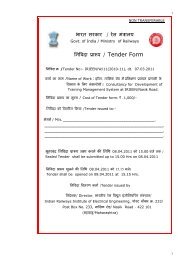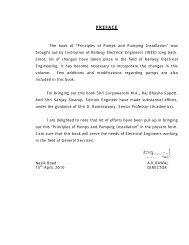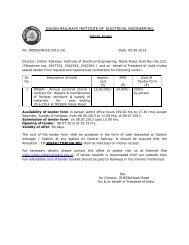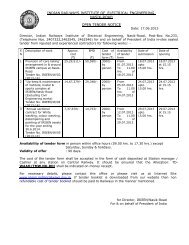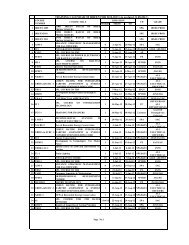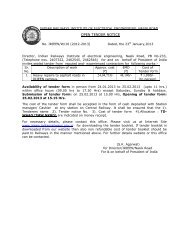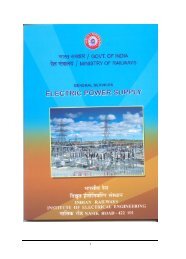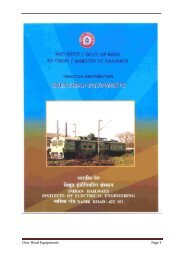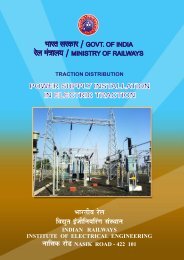Traction Rolling Stock - Indian Railways Institute of Electrical ...
Traction Rolling Stock - Indian Railways Institute of Electrical ...
Traction Rolling Stock - Indian Railways Institute of Electrical ...
Create successful ePaper yourself
Turn your PDF publications into a flip-book with our unique Google optimized e-Paper software.
When the brake valve handle is moved from release position towards application position, the<br />
brake pipe pressure and vacuum in VTP is reduced and maintained to a value depending on the<br />
handle movement.<br />
The reduction in brake pipe pressure operates the VA-1B control valve to admit<br />
atmospheric air into the vacuum train pipe, to apply brakes on the vacuum braked trailing stock.<br />
During application, the exhauster connection with the vacuum train pipe is cut <strong>of</strong>f by the VA-1B<br />
control valve. After the desired degree <strong>of</strong> brake application has taken place, depending upon the<br />
extent <strong>of</strong> brake pipe pressure desired, the valve laps and maintains automatically the vacuum level<br />
against normal vacuum train pipe leakage.<br />
When the driver feels that it is not necessary to apply brake on a loco, the brake release<br />
pedal switch is pressed to release the loco brakes. The D-l air pilot is energised to cut <strong>of</strong>f<br />
automatic air brakes on the loco while train brakes remain applied on the trailing stock.<br />
During train parting while hauling vacuum braked stock, the vacuum in the train pipe<br />
falls suddenly, with a drop <strong>of</strong> vacuum by about 10 to 15 cm an unbalance in the VA-1B control<br />
valve is created allowing controlled air pressure to actuate HB-5 relay air valve to operate pressure<br />
switch through double check valve for regression <strong>of</strong> power.<br />
7.2.7 Operation <strong>of</strong> emergency brake (Ref. fig. 7.2.4)<br />
D-l air pilot provided in each cab, near the assistant driver's seat directly connects the<br />
vacuum train pipe and air brake pipe to atmosphere thereby applying brakes on loco and trailing<br />
stock at the quickest possible rate. The circuit for auto regression <strong>of</strong> the loco power due to the<br />
actuation <strong>of</strong> H-5 relay air valve is also automatically made. This relay valve also regresses power if<br />
the BP pressure drops due to any reason.<br />
7.2.8 Dynamic brakes<br />
D-l pilot air valve cuts <strong>of</strong>f loco brakes.<br />
While controlling the train with dynamic brakes, if the dynamic brake fails, brakes on the<br />
loco and train will be applied automatically.<br />
7.2.9 Air flow indicator<br />
Air flow indicator, a relay valve, one pressure switch and two flow indicator gauges (one<br />
in each cab) have been provided to give an indication <strong>of</strong> the air flow rate in the brake pipe <strong>of</strong> the<br />
train. Any abnormal increase in air flow in the brake pipe because <strong>of</strong> train parting, loco parting,<br />
alarm chain pulling, heavy leakage in brake in brake pipe, guard valve application or bursting <strong>of</strong> air<br />
brake pipe hose will give visual indication to the driver by air flow gauge needle and by glowing <strong>of</strong><br />
a bulb in the cab. On getting the indication driver shall apply brakes through A-9 automatic brake<br />
valve/D-l air/vacuum emergency valve depending upon the condition <strong>of</strong> the train and the<br />
emergency.<br />
7.2.10 Operation <strong>of</strong> brakes during multiple unit operation <strong>of</strong> locos (Ref. fig.7.2.8)<br />
When the locos are connected for multiple unit operation following pipes should be<br />
connected to each other and the angle cocks <strong>of</strong> these pipes to remain open at the coupled end<br />
closed on the free end.




